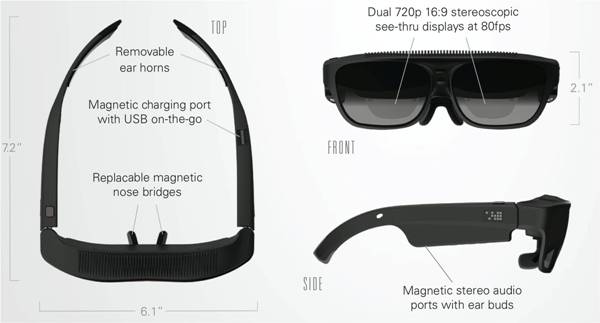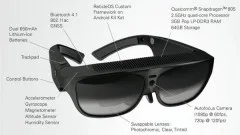After many announcements, ODG (Osterhout Design Group) is now offering the R7 smartglasses for pre-order on its website. They earlier announced the R7 device as well as a more consumer-oriented device, at CES 2015 and other conferences.
The R7 has a binocular design with all the consumer electronics one would dare to put in a pair of glasses. As the images show, ODG went to some lengths to make this a real stand-alone product with computer power rivaling a high end smartphone. From the quadcore Qualcomm snapdragon 805 processor, 64 GB of storage to autofocus camera and Bluetooth / WiFi connectivity the feature list reads more like a smartphone than a pair of smartglasses.
 Source: Osterhout Design Group
Source: Osterhout Design Group
The device has a built in battery with 1,300 mAh, which should give the device a decent battery life, even though ODG does not comment on this at all. On the other hand, this adds to the overall weight, although ODG hasn’t released that yet either. From a user perspective, battery life and comfortable usage time need to be balance. If the device is so heavy that the user wants to take it off after 30 min, a 10h battery life seems complete overkill.
With wearing comfort an important issue for this device type, ODG is offering magnetically attached replaceable nose bridges and photochromic shields to create a better experience for the user.
From a display standpoint, the glasses feature two 720p displays running at 80fps to create a flicker free viewing experience. They are not saying what type of display technology and optical system they are using, but the images confirm that they are not using a Google Glass type optical combiner cube but rather a thin film based approach. They are stating however that the displays have an 80% see-through transparency.
 Source: Osterhout Design Group
Source: Osterhout Design Group
ODG states very clearly that the device is aiming at the professional market rather than the consumer market. The firm sees the consumer market as not being ready to adopt smartglasses at this time. The R7 carries MIL standards certification as well as ANSI Z87.1 compliance for hazardous environments.
As expected, such a device does not come cheap, and ODG is offering it with a US$2,750 price tag, surely outside of the range suitable for consumer adoption. They are offering a 25% discount for approved developers in the hope to attract more industrial application development. As far as delivery goes, they are in the beta product stage and expect delivering product in the fourth quarter this year. (NH)

